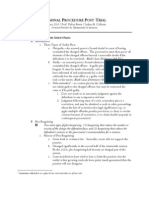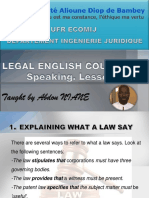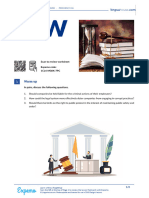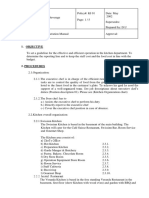Legal Vocabulary in Use British English Student
Legal Vocabulary in Use British English Student
Uploaded by
maciejjachim213Copyright:
Available Formats
Legal Vocabulary in Use British English Student
Legal Vocabulary in Use British English Student
Uploaded by
maciejjachim213Original Title
Copyright
Available Formats
Share this document
Did you find this document useful?
Is this content inappropriate?
Copyright:
Available Formats
Legal Vocabulary in Use British English Student
Legal Vocabulary in Use British English Student
Uploaded by
maciejjachim213Copyright:
Available Formats
HEAAADERLOGORIGHT
LEGAL ENGLISH · LEGAL ISSUES · UPPER-INTERMEDIATE (B2-C1)
LEGAL
VOCABULARY
IN USE
QrrkoD Scan to review worksheet
Expemo code:
1BI9-Q1IB-S8DB
1 Warm up
Part A: Decide who is represented by each of the photographs from the following options.
barrister judge jury solicitor
1. 2. 3. 4.
Part B: Now match these answers with the definitions below.
1. a type of lawyer in the UK who gives specialised legal advice and can argue
a case in both higher and lower courts
2. a person who is in charge of a trial in a court and decides how a person who is
guilty of a crime should be punished or who makes decisions on legal matters
3. a type of lawyer who is trained to prepare cases, give advice on legal subjects
and can represent people in lower courts
4. a group of people who have been chosen to listen to all the facts in a criminal
trial and to decide if a person is guilty or not guilty, or if a claim has been
proved
FOOOOTERRIGHT Learn without forgetting! 1/7
Scan the QR at the top of Page 1 to review the lesson flashcards with Expemo.
© Linguahouse.com. Photocopiable and licensed for use in ___'s lessons.
HEAAADERLOGORIGHT
UPPER-INTERMEDIATE (B2-C1)
LEGAL VOCABULARY IN USE
2 Legal vocabulary
Part A: Match the vocabulary with the correct definition.
1. armed robbery (n) a. a covering of hair that can be removed and is worn on the
head to hide a lack of hair or to cover your own hair
2. indictable (adj.) b. a person who sees a crime or an accident
3. appeal (n) c. the rooms used by a barrister or a group of barristers
4. conviction (n) d. a request made to a court of law or to someone in authority
to change a previous decision
5. brief (n) e. the fact of officially being found guilty of a particular crime,
or the act of officially finding someone guilty
6. witness (n) f. a document that shows the facts of a legal case that will be
argued by a lawyer in a court
7. prenuptial agreement (n) g. making it possible for someone to be accused officially of a
crime
8. firm (n) h. an official document signed by two people before they get
married that says what will happen to their possessions
and/or children if they divorce
9. chambers (n) i. a business that is engaged in the practice of law
10. wig (n) j. the crime of stealing from somewhere or someone using
weapons
Part B: Complete the sentences with the missing words from Part A. You may need to change the
form of the word.
1. After I graduated, I joined a that specialises in property law.
2. He committed a number of serious crimes, such as .
3. Wearing a brings a sense of tradition and formality to legal proceedings.
4. Initially, the man was found guilty, but he made an to a higher court
and was found not guilty.
5. offences are normally more serious and result in longer sentences.
6. The divorce was straightforward as they had a .
7. She already had a number of before she committed the crime.
8. All the details of the case and the witnesses’ statements were contained within the
.
9. The majority of barristers’ are in London as this is where most of
the courts are.
10. Many saw the crime being committed and were able to give evidence.
FOOOOTERLEFT Learn without forgetting! 2/7
Scan the QR at the top of Page 1 to review the lesson flashcards with Expemo.
© Linguahouse.com. Photocopiable and licensed for use in ___'s lessons.
HEAAADERLOGORIGHT
UPPER-INTERMEDIATE (B2-C1)
LEGAL VOCABULARY IN USE
3 Listening for gist
You will hear a podcast about the roles of barristers and solicitors. State what the following figures
relate to.
1. four years →
2. 220,000 →
3. 250,000 →
4 Listening comprehension
Listen to the podcast again in more detail and choose the correct answer.
1. Where do trials for serious crimes take place?
a. Family Court
b. Chambers
c. Crown Court
2. What does a defence barrister have to prove?
a. that their client is not guilty
b. that their client is innocent
c. that they have sufficient evidence
3. What might a brief contain?
a. recommendations for the judge
b. witnesses who will be called
c. a summary of family law
4. Why do barristers often share chambers?
a. to save on certain costs
b. to be able to get advice from solicitors
c. to be nearer to the courts
FOOOOTERRIGHT Learn without forgetting! 3/7
Scan the QR at the top of Page 1 to review the lesson flashcards with Expemo.
© Linguahouse.com. Photocopiable and licensed for use in ___'s lessons.
HEAAADERLOGORIGHT
UPPER-INTERMEDIATE (B2-C1)
LEGAL VOCABULARY IN USE
5 Legal vocabulary
Complete the following sentences using the words and expressions below. You may need to change
the tense of some of the words.
bound breached duty of care liable
precedent sentencing guidelines severity standard of proof
1. Employers have a to protect their workers and visitors.
2. The prosecuting barrister argued that the defendant was and should
pay compensation.
3. The judge´s ruling was based on a set by a previous decision.
4. He claims the city council their contract by selling the property.
5. The of the crime meant that he was given a prison sentence.
6. The contract meant she was legally to not spend any of the money.
7. According to , someone found guilty of stealing from a shop can
receive a prison sentence of up to three years.
8. They submitted enough evidence that the was met and the accused
was found guilty.
6 Reading comprehension
Read the three texts about civil, criminal, and common law (page five). Decide whether the following
statements are true (T) or false (F).
1. Under civil law, the person who is accused is known as the claimant.
2. Breaches of civil law often involve the payment of compensation.
3. If you are accused of a crime, you always face a trial in the County Court.
4. Criminals might have to pay a financial penalty.
5. Judges usually have to follow the decisions made in previous cases to resolve a dispute.
FOOOOTERLEFT Learn without forgetting! 4/7
Scan the QR at the top of Page 1 to review the lesson flashcards with Expemo.
© Linguahouse.com. Photocopiable and licensed for use in ___'s lessons.
HEAAADERLOGORIGHT
UPPER-INTERMEDIATE (B2-C1)
LEGAL VOCABULARY IN USE
Civil law concerns cases between people or between people and organisations.
Breaches of civil law involve offences that are harmful towards another person,
their rights, or their property. In civil law, the person bringing the claim is called
the "claimant". The person accused is referred to as the "defendant". These types
of cases are typically centred around establishing whether the defendant had a
duty of care towards the claimant or not. Unlike criminal law, you will not be sent
to prison if you are found guilty. Those who are convicted of a civil offence are
however usually liable for compensation. The standard of proof used for civil law
cases is based on "the balance of probabilities".
Criminal law relates to offences that have a negative impact on society, not just
one person. When a person commits a criminal act, in breach of criminal law,
then they will face a trial at the Magistrates’ Court or the Crown Court. If found
guilty of a crime, they will receive a penalty in line with the legislation and
sentencing guidelines. This may be a fine, community order, or even a prison
sentence, depending on the severity of the crime. The standard of proof required
for a conviction is that the crime happened "beyond a reasonable doubt".
Common law is the legal system used in England and Wales. It is mainly based on
the idea of precedent - when a court makes a decision about a case, that decision
then becomes a part of the law. For example, murder is not illegal in England
because of a law made by the government, but because of the decisions of
judges in earlier murder cases. Furthermore, if a court finds that a similar dispute
as the present one has been resolved in the past, the court is bound to follow the
reasoning used in the previous decision. However, it is possible for governments
to add to or modify common law via Acts of Parliament.
7 Reading: general understanding
Look at the headlines below and decide whether, if brought to court, they would be civil or criminal
cases.
1. Woman sues hospital after misdiagnosis
2. Eight men arrested for suspected drug trafficking
3. Police investigate arson attacks
4. Woman’s death the latest in a string of murders
5. Shop assistant sues boss after injury at work
6. Man takes building company to court over badly-built kitchen
FOOOOTERRIGHT Learn without forgetting! 5/7
Scan the QR at the top of Page 1 to review the lesson flashcards with Expemo.
© Linguahouse.com. Photocopiable and licensed for use in ___'s lessons.
HEAAADERLOGORIGHT
UPPER-INTERMEDIATE (B2-C1)
LEGAL VOCABULARY IN USE
8 Talking point
In civil cases, the standard of proof is based on the balance of probabilities, while in criminal cases it
is beyond a reasonable doubt.
1. Which do you think involves a higher level of proof?
2. Why do you think the level of proof is different depending on the type of law?
9 Legal vocabulary
Complete the definitions by using a word from the box below.
compensation decision evaluation evidence
evidence facts mistake resolving
1. submission (n) - a suggestion or request that is given to a judge who is asked to make a
about it
2. witness statement (n) - a signed document recording the of a witness
3. claim form (n) - a formal written request to someone for
4. Particulars of Claim (n) - a document setting out the case of a claimant that specifies the
relied upon
5. disclose (v) - make available
6. dispute resolution procedure (n) - the process of a dispute between
different parties through mediation
7. flaw (n) - a fault, , or weakness
8. judicial discretion (n) - a judge’s power to make a decision based on their personal
, guided by the principles of law
FOOOOTERLEFT Learn without forgetting! 6/7
Scan the QR at the top of Page 1 to review the lesson flashcards with Expemo.
© Linguahouse.com. Photocopiable and licensed for use in ___'s lessons.
HEAAADERLOGORIGHT
UPPER-INTERMEDIATE (B2-C1)
LEGAL VOCABULARY IN USE
10 Making a criminal claim
The statements below are steps in the civil litigation process. Put the steps in the correct order.
The judge makes their decision. The losing party normally has to cover the winner’s costs. This
amount is down to judicial discretion.
Parties are required to disclose all the relevant documents in their possession.
Barristers sum up the evidence and make submissions on the relevant law.
A Claim Form is submitted to the court and to the defendant that includes the Particulars of
Claim. This states a summary of the facts against the defendant.
Parties are encouraged to use alternative dispute resolution procedures (ADR) to avoid costs. If
this is unsuccessful, the court sets down a timetable to progress the issue to trial.
The defendant has 28 days in which to respond if they wish to defend the claim.
During the trial, witnesses give evidence. They are cross-examined to reveal flaws in their case.
Witness statements are exchanged, which set out the facts that they will testify to in court.
11 Homework/optional extension
Task A: Complete the following sentences using words or phrases from the lesson.
1. A prepares cases for court and offers advice on legal matters.
2. Before they got married, both parties signed a .
3. A young woman who saw the accident was called to give evidence as a .
4. When he makes an against the decision, he hopes the judge makes
a different verdict.
5. The judge followed the and sent him to prison for three years.
6. The is high in murder trials as a person’s freedom is at stake.
7. The original legal had been set three years earlier in a previous case.
8. Before a trial, both parties are expected to evidence to each other.
9. Property damage is a crime that is dealt with by law.
10. She appealed unsuccessfully against her for murder.
Task B: Discuss the questions in pairs or small groups.
1. Is there a similar system of solicitors and barristers in your country?
2. Why do you think juries are used in criminal cases?
3. Have you ever served on a jury, or do you know anyone who has?
FOOOOTERRIGHT Learn without forgetting! 7/7
Scan the QR at the top of Page 1 to review the lesson flashcards with Expemo.
© Linguahouse.com. Photocopiable and licensed for use in ___'s lessons.
You might also like
- Law British English TeacherDocument13 pagesLaw British English Teachereleonorasultanova1982No ratings yet
- Vocabulary Exercises 1. Fill in The Gaps With The Following Words: Infringements, Enforce, ProtectDocument4 pagesVocabulary Exercises 1. Fill in The Gaps With The Following Words: Infringements, Enforce, ProtectJeimy VelascoNo ratings yet
- CM1 Specimen Questions and SolutionsDocument5 pagesCM1 Specimen Questions and SolutionsBakari HamisiNo ratings yet
- Manual Engleza Juridica An 1Document120 pagesManual Engleza Juridica An 1Nma Alin0% (1)
- English in Law: A Compendium of Legal English for pre-intermediate, intermediate and upper-intermediate studentsFrom EverandEnglish in Law: A Compendium of Legal English for pre-intermediate, intermediate and upper-intermediate studentsNo ratings yet
- ProclamationDocument3 pagesProclamationJosimar AraujoNo ratings yet
- Legal Vocabulary in Use British English TeacherDocument12 pagesLegal Vocabulary in Use British English TeacherDariia SemilietovaNo ratings yet
- Former Us President Donald Trump Indicted British English Student B2 C1Document9 pagesFormer Us President Donald Trump Indicted British English Student B2 C1Svetlana StorozhukNo ratings yet
- Legal English Upper Intermediate Review 3 British English StudentDocument8 pagesLegal English Upper Intermediate Review 3 British English StudentКатяNo ratings yet
- Legal English Upper Intermediate Review 3 British English TeacherDocument11 pagesLegal English Upper Intermediate Review 3 British English TeacherКатяNo ratings yet
- Remedial Law MCQDocument28 pagesRemedial Law MCQalexes negroNo ratings yet
- Exercises On English For Business Law (VB2)Document52 pagesExercises On English For Business Law (VB2)Khanh NguyenNo ratings yet
- TrustandestatesDocument11 pagesTrustandestatesGreta CarterNo ratings yet
- Exercises On English For Business Law (VB2)Document52 pagesExercises On English For Business Law (VB2)Nhung NguyễnNo ratings yet
- Project Unit 1Document10 pagesProject Unit 1mon monNo ratings yet
- Clj-Sfc-By Atty. JMFDocument27 pagesClj-Sfc-By Atty. JMFErmelito Dela Rosa Jr.No ratings yet
- Evidence Under The Rules NotesDocument19 pagesEvidence Under The Rules NotesporkyxpNo ratings yet
- MCQS, Criminal LitigationDocument100 pagesMCQS, Criminal LitigationNelson IheanachoNo ratings yet
- EXERCISES E9f6401bfeb5f0f1fc8d42e294f57a8Document5 pagesEXERCISES E9f6401bfeb5f0f1fc8d42e294f57a8runa kkkNo ratings yet
- EvidenceDocument50 pagesEvidencetennis123123No ratings yet
- Professional EthicsDocument1 pageProfessional EthicsPramod KumarNo ratings yet
- Law British English StudentDocument8 pagesLaw British English StudentS Zai100% (1)
- Gilbert - S Civil Procedures OutlineDocument14 pagesGilbert - S Civil Procedures Outlineyjtqk5j72tNo ratings yet
- Inglés II. Dos SesionesDocument21 pagesInglés II. Dos SesionesdcperezhNo ratings yet
- Subj. Evidence CrimDocument4 pagesSubj. Evidence Crimhahak dogNo ratings yet
- Leg Tech ReviewerDocument11 pagesLeg Tech ReviewerAbriNo ratings yet
- Legal ProfessionsDocument16 pagesLegal ProfessionsveneraNo ratings yet
- Crim Pro Post Trial Reece Summer 10Document84 pagesCrim Pro Post Trial Reece Summer 10Joshua Ryan CollumsNo ratings yet
- I. General Principles: Quasi in RemDocument10 pagesI. General Principles: Quasi in RemCorey RemetreNo ratings yet
- Law British English TeacherDocument13 pagesLaw British English Teacherf98ykjhtm8No ratings yet
- Law British English Student C2Document8 pagesLaw British English Student C2Svetlana StorozhukNo ratings yet
- Civ Pro NotesDocument29 pagesCiv Pro NotesMichael MoonNo ratings yet
- EvidenceDocument69 pagesEvidencecm45761No ratings yet
- Legal English Course - ECOMIJ L1 - Lesson 2Document7 pagesLegal English Course - ECOMIJ L1 - Lesson 2ATEKH NDIAYENo ratings yet
- Legal Forms Course Syllabus of Atty. ROMMEL C. TINGADocument6 pagesLegal Forms Course Syllabus of Atty. ROMMEL C. TINGAPAULAMIKHAELA ARIASNo ratings yet
- Criminal EvidenceDocument7 pagesCriminal Evidenceamagpantay114No ratings yet
- Atp 100 - DDocument48 pagesAtp 100 - DPioneer TutorsNo ratings yet
- Individual Work: State University of The Republic of Moldova Faculty of LettersDocument13 pagesIndividual Work: State University of The Republic of Moldova Faculty of LetterseugeniaNo ratings yet
- Law British English StudentDocument8 pagesLaw British English Studenteleonorasultanova1982No ratings yet
- Іnternational legal english12-16Document5 pagesІnternational legal english12-16JasiokNo ratings yet
- Questions 2009Document37 pagesQuestions 2009Tannie Lyn Ebarle BasubasNo ratings yet
- Documents in A CourtDocument1 pageDocuments in A CourtDaouda ThiamNo ratings yet
- Sir Micho Fastrack Coaching in Technical Writing 1 and 2Document6 pagesSir Micho Fastrack Coaching in Technical Writing 1 and 2Abdulhakim BasirNo ratings yet
- First Periodocal Examination Crim 057 Answer KeyDocument4 pagesFirst Periodocal Examination Crim 057 Answer Keybryleelizerc.burdanNo ratings yet
- Модуль 2 ПР - юристиDocument96 pagesМодуль 2 ПР - юристиГуменюк РоманNo ratings yet
- Law British English StudentDocument8 pagesLaw British English StudentSofiaNo ratings yet
- Remedial Law Syllabus 2021Document10 pagesRemedial Law Syllabus 2021Francisco BanguisNo ratings yet
- Exam in Civic Education - XB DoneDocument4 pagesExam in Civic Education - XB DoneMohammad DurrazhiNo ratings yet
- August2023-Clj FC by Atty. Jmf-Ans. KeyDocument28 pagesAugust2023-Clj FC by Atty. Jmf-Ans. KeyAphrodi XNo ratings yet
- C - Criminal Procedure OutlineDocument14 pagesC - Criminal Procedure OutlineAlex De La TorreNo ratings yet
- Part 3 FinaDocument20 pagesPart 3 FinaMaria Resper LagasNo ratings yet
- Erlaine Vanessa D. Lumanog Constitutional Law 2 - Atty. MedinaDocument23 pagesErlaine Vanessa D. Lumanog Constitutional Law 2 - Atty. MedinaAndrea Gural De GuzmanNo ratings yet
- Conflicts of Law Midterms ReviewerDocument7 pagesConflicts of Law Midterms ReviewerCatherine David100% (1)
- Guide To Preparing For A Family Court Trial in Provincial CourtDocument22 pagesGuide To Preparing For A Family Court Trial in Provincial CourtTUP TutorsNo ratings yet
- Criminal Justice SystemDocument6 pagesCriminal Justice Systemamagpantay114No ratings yet
- Law British English TeacherDocument13 pagesLaw British English TeacherDacus DacusNo ratings yet
- Evidence Q and ADocument47 pagesEvidence Q and AHarold Bindadan100% (1)
- Criminal Law MCQDocument25 pagesCriminal Law MCQalexes24100% (1)
- Heinous, Atrocious & Cruel: The Casebook of a Death Penalty AttorneyFrom EverandHeinous, Atrocious & Cruel: The Casebook of a Death Penalty AttorneyRating: 4 out of 5 stars4/5 (1)
- English in Law (Advanced): A Compendium of Legal English for Advanced and Proficiency StudentsFrom EverandEnglish in Law (Advanced): A Compendium of Legal English for Advanced and Proficiency StudentsNo ratings yet
- How one of my Pro-se cases got destroyed by federal rogue judgesFrom EverandHow one of my Pro-se cases got destroyed by federal rogue judgesNo ratings yet
- Law School Survival Guide (Volume I of II) - Outlines and Case Summaries for Torts, Civil Procedure, Property, Contracts & Sales: Law School Survival GuidesFrom EverandLaw School Survival Guide (Volume I of II) - Outlines and Case Summaries for Torts, Civil Procedure, Property, Contracts & Sales: Law School Survival GuidesNo ratings yet
- Google Terms of Service en EuDocument20 pagesGoogle Terms of Service en EucacaolesNo ratings yet
- 09200-En-30 Process Facility Site Change ManagementDocument6 pages09200-En-30 Process Facility Site Change ManagementfernandoNo ratings yet
- Republic of The Philippines Bohol Island State University: Sexual Harassment What Is Sexual Harassment?Document2 pagesRepublic of The Philippines Bohol Island State University: Sexual Harassment What Is Sexual Harassment?Timbal Allen JamesNo ratings yet
- Butterfly CircusDocument2 pagesButterfly CircusSalma BenjellounNo ratings yet
- Article WritingDocument3 pagesArticle Writingheadhunter1309No ratings yet
- CV-Abdullah WaheediDocument3 pagesCV-Abdullah Waheedijawadwafa795No ratings yet
- Geoffery Chaucer - 2in1Document13 pagesGeoffery Chaucer - 2in1Adnan SiddiqueNo ratings yet
- Phuket Beach HotelDocument5 pagesPhuket Beach HotelAshadi Cahyadi100% (1)
- CorporateDocument30 pagesCorporateMalik JeeNo ratings yet
- Group7 Activity3Document4 pagesGroup7 Activity3Pearl Alexandra FabitoNo ratings yet
- 2012 Wafa AhmedDocument113 pages2012 Wafa Ahmedhacer SönmezNo ratings yet
- Activity Sheets in TLE-ICT Quarter 1-Week 3 - Module 3Document2 pagesActivity Sheets in TLE-ICT Quarter 1-Week 3 - Module 3Sonny Matias100% (8)
- Terraform Associate Study GuideDocument3 pagesTerraform Associate Study Guidemanuvrat23No ratings yet
- Instructions For Enlistment of Contractors in PUNJAB PWD (B&R) - 2016Document51 pagesInstructions For Enlistment of Contractors in PUNJAB PWD (B&R) - 2016Manjit SinghNo ratings yet
- Lee Vs CA 215 SCRA 752Document2 pagesLee Vs CA 215 SCRA 752Chino CabreraNo ratings yet
- Depression ScriptDocument2 pagesDepression ScriptCole HaggarNo ratings yet
- (Britannia) AnsoffDocument4 pages(Britannia) AnsoffSRISHTI NARANGNo ratings yet
- QinetiQ Sustainable Procurement GuideDocument32 pagesQinetiQ Sustainable Procurement GuideanhthutangocNo ratings yet
- Poster NSE 2020 PDFDocument1 pagePoster NSE 2020 PDFAashirwadNo ratings yet
- Rizal AncestryDocument4 pagesRizal AncestrybtstanNo ratings yet
- Opportunities For Coastal Wetland Restoration For Blue Carbon With Co-Benefits For Biodiversity, Coastal Fisheries, and Water QualityDocument11 pagesOpportunities For Coastal Wetland Restoration For Blue Carbon With Co-Benefits For Biodiversity, Coastal Fisheries, and Water Qualitymathi.mallatNo ratings yet
- Kitchen GeneralDocument5 pagesKitchen Generaljohn carterNo ratings yet
- FUELSEUROPE - Graph 2018-37Document1 pageFUELSEUROPE - Graph 2018-37MajugoNo ratings yet
- Entry of Corporate Houses in Retail Trade - The View Point of TradersDocument7 pagesEntry of Corporate Houses in Retail Trade - The View Point of TradersAashutosh KhadkeNo ratings yet
- Development Support CommunicationDocument12 pagesDevelopment Support CommunicationNikhil Yadav100% (2)
- 12 Painting-Chapter-The Bengal School of Painting-NotesDocument9 pages12 Painting-Chapter-The Bengal School of Painting-NotesPrataya Das54% (24)
- HRM Case Study - 2021Document46 pagesHRM Case Study - 2021Le HieuNo ratings yet
- OPS 02 - Pre-Visit Checklist For SuperintendentsDocument6 pagesOPS 02 - Pre-Visit Checklist For SuperintendentsEmre AlgülNo ratings yet

























































































